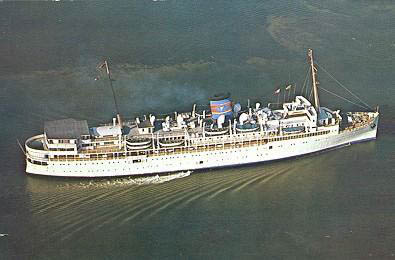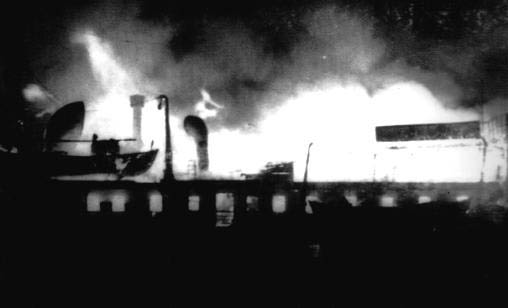When you search for Gordon Lightfoot on YouTube, you’ll find a plethora of alternative renditions of his most renowned song, “The Edmund Fitzgerald.” Even those who aren’t interested in shipwrecks are likely familiar with this tune, which is one of Gordon’s most well-known.
The Ballad of the Yarmouth Castle albeit less well-known and never issued as a single, tells the story of another shipwreck tragedy, though not in Canadian waters. She was an American steamship whose sinking in a devastating fire in 1965 triggered new maritime safety regulations. The ship was the second of two similar ships built by the William Cramp & Sons Ship and Engine Building Company for the Eastern Steamship Lines for duty on the New York – Yarmouth, Nova Scotia route.
She sailed under the name Evangeline until she was sold and renamed Yarmouth Castle after being put under Panamanian register. Due to financial difficulties, the ship’s operators continued to run the ship between Miami and Nassau, Bahamas, until the accident on November 12, 1965.
On November 12, 1965, the Yarmouth Castle sailed Miami for Nassau, carrying 376 passengers and 176 staff members for a total of 552 people. The ship was scheduled to dock in Nassau the following day. Byron Voutsinas, 35, was the Captain for the trip.

On November 13, shortly after midnight, a fire broke out in room 610 on the main deck. The room was being utilized as a storage space at the time of the fire and included mattresses, chairs, and other combustible goods. There was no sprinkler head in the room. The cause of the fire was unknown; it could have been caused by improvised wiring or sparks entering through the ventilation system. Between 12:30 and 12:50 a.m., a watchman conducted a security patrol but failed to inspect all parts of the ship and detect the fire. Between the hours of midnight and 1:00 a.m., the crew and passengers noticed smoke and heat and began looking for a fire.
It had already started to spread when they discovered it in room 610 and the toilet above, and attempts to put it out with fire extinguishers were ineffective. Attempts to activate a fire alarm system failed as well. Until about 1:10 a.m., the bridge was ignorant of the fire. Yarmouth Castle was 120 miles east of Miami and 60 miles northwest of Nassau at this moment. The engine room notified the bridge at 1:00 a.m. that smoke was coming from the ventilation system. The captain was called to the bridge, told the crew to sound the alarm, and then left to find the fire. The general alarm was not activated, and no notifications were issued over the PA system. The general alarm would have sounded all of the ship’s alarm bells, alerted the passengers, and and summoned off-duty personnel to the emergency stations.
The captain returned to the bridge after roughly five minutes and ordered the ship to be stopped at 1:20 a.m. Because of the fires and smoke in the radio room, the radio officer was unable to issue a distress call. The crew was forced to evacuate the bridge due to the fire, and the captain gave the order to abandon ship around 1:25 a.m. The general alarm could no longer be raised, and they couldn’t use the ship’s whistle to send the whole “abandon ship” signal.
The surviving crew then attempted to notify passengers and assist them in escaping their staterooms. Some passengers attempted to flee through the cabin windows, but due to poor upkeep, these were difficult or impossible to open. The sprinkler system was triggered, however due to the ferocity of the fire, it was mainly useless. While several lifeboats caught fire and others were unable to launch due to mechanical issues, half of the ship’s lifeboats made it to safety. Passengers at the bow were unable to reach the lifeboats and were later rescued by rescue boats.
The Finnpulp, a Finnish freighter, was only eight miles ahead of Yarmouth Castle, while the Bahama Star, a passenger liner, was around twelve miles behind it. Both ships sped ahead/behind to assist the Castle. The Finnpulp was the first on the scene, assisting the first lifeboat, which was carrying the captain of the Yarmouth Castle. The freighter then turned to rescue more passengers from the burning ship after scooping up the passengers and some crew from that boat. Finnpulp also dispatched its own rescue boats to assist passengers. Bahama Star had arrived on the scene by this time. The ship came to a halt 100 yards from Yarmouth Castle and launched lifeboats that lined up against the blazing ship’s starboard side. Several people dove into the ocean and boarded the lifeboats. Others used ropes and rope ladders to descend.
The Finnpulp successfully called the Coast Guard in Miami at 1:36 a.m. It was the first time a distress signal had been sent out. The US Coast Guard began dispatching planes and eventually helicopters to assist in the rescue around 2:30 a.m. The airborne activities would go on for the rest of the day. By 4:00 a.m., all survivors had been rescued and boarded the Finnpulp and Bahama Star.
Yarmouth Castle toppled over onto her port side shortly before 6:00 a.m. and sank at 6:03 a.m.
The ship sank with 87 people on board, and three of the rescued passengers died later in hospitals, bringing the total death toll to 90. Only two of the dead were crew members. While some bodies were retrieved, most of those lost, (some passengers and crew) perished along with the ship.
The fire at Yarmouth Castle was the worst in North American seas since the SS Noronic sank and burned in Toronto Harbour in 1949, killing up to 139 people.
Investigation
The United States Coast Guard began an inquiry into the sinking, which resulted in a 27-page report in March 1966.
The Yarmouth Castle disaster prompted updates to the Safety of Life at Sea law, or SOLAS. The updated law brought new maritime safety rules, requiring fire drills, safety inspections, and structural changes to new ships. Under SOLAS, any vessel carrying more than 50 overnight passengers is required to be built entirely of non-combustible materials such as steel. Yarmouth Castle’s largely wooden superstructure was found to be the main cause of the fire’s rapid spread.
Yarmouth Castle is located on the border of the Grand Bahama Basin, west of Castaway Cay and northwest of Great Harbour Cay, on the bottom of the Atlantic Ocean. The depth of the wreckage is over 10,800 feet. There are no internet records of the wreck ever being investigated, implying that it is most likely unexplored.
In the 1962 James Bond film Dr. No, the Yarmouth Castle (formally the Evangeline} makes an appearance. During a scene where Bond meets Quarrel at the Nassau boat docks, it can be seen in the backdrop.
Gordon Lightfoot’s first shipwreck song, The Ballad of the Yarmouth Castle, was based on the tragedy. In 1969, it was included on his fifth United Artists album, Sunday Concert. The Edmund Fitzgerald was his second shipwreck song, as the Fitzgerald went down in 1975.





